Douglas F3D Skyknight
Douglas designed the aircraft around the bulky air intercept radar systems of the era, resulting in a wide, deep, and roomy fuselage that accommodated its two-man crew.[additional citation(s) needed] This may be in reference to its age, unflattering looks, or the low-slung air intakes that made it vulnerable to foreign object damage (FOD).[5][unreliable source] The F3D was not intended to be a typical sleek and nimble dogfighter, but as a standoff night fighter, being outfitted with a powerful radar system and a second crew member.Aviation author Joe Copalman observed that the F3D was a relatively conventional aircraft, despite its use of jet propulsion, the design team having opted for features such as a straight wing and traditional tail unit.[8] A large and relatively flat forward windshield was used; while not conducive to high speed flight, it provided distortion-free external visibility, something that was particularly valued for a night fighter at that time.The use of ejection seats was also considered but decided against as their inclusion would have necessitated a jettisonable canopy, made pressurizing the cockpit more difficult, and added weight.[9] The XF3D-1 was selected over a competing submission, Grumman Aircraft Engineering Corporation's G-75 twin-seat, four-engined, Westinghouse J30-powered night fighter design (similar layout to their Tigercat), leading to an initial contract being issued on 3 April 1946.These units were powered by a pair of Westinghouse J34-WE-24 turbojets, capable of 3,000 lbf (13 kN) thrust, which were installed underneath the roots of then-standard straight wings of the early jet era.[8][19] The complexity of this vacuum tube-based radar system, produced before the advent of semiconductor electronics, required intensive maintenance to keep it operating properly.[16] Additional changes on the F3D-2 included the incorporation of an improved Westinghouse AN/APQ-36 fire control system, autopilot, air conditioning, and a bulletproof windscreen.Ground-based anti-aircraft artillery, which was often equipped with radar-guided search lights, proved to be more of a threat to night time operations over Korea than the occasional MiG-15; such aircraft often acted as bait, attempting to draw the Skyknights into coordinated traps.[30] The first air-to-air victory was recorded on the night of 2 November 1952 by a USMC F3D-2 piloted by Major William T. Stratton Jr., and his radar operator, Master Sergeant Hans C. Hoglind of VMF(N)-513 Flying Nightmares,[31] Major Stratton shot down what he believed was a Yakovlev Yak-15 (even though no Yak-15s were reported in Korea)[5] which was the first successful night radar interception by a jet of another jet.[33] In January 1953, the number of USMC Skyknights in Korea was doubled to 24; this increase allowed them to effectively escort B-29 Superfortresses on night bombing missions.The mission of VC-4 DET44N as directed by Commander Task Force NINETY-ONE and as employed as an integral part of Marine All Weather Fighter Squadron 513 based ashore, providing night fighter escort for U.S. Air Force medium bomber (B-50) strikes on targets in North Korea and providing night combat air patrols in the Chodo Island area, extending from the Haeju peninsula to the Yalu River.[37] One F3D, piloted by LTJG Bob Bick and his RO, Chief Petty Officer Linton Smith, was lost to enemy fire on 2 July 1953.[37] While the Skyknight lacked the swept wings and high subsonic performance of the MiG-15, its powerful fire control system enabled it to find and shoot down other fighters at night, while most MiG-15s could only be guided by ground-based radar.[citation needed] During 1959, Ed Heinemann proposed that Douglas refurbish retired F3Ds for civil use, reasoning that the former military aircraft could be offered at a much lower price than newly designed business jets such as the Lockheed JetStar.Some work on the initiative was undertaken, but it was canceled after it was determined that the stored aircraft were in a generally poor condition, making their refurbishment more costly than forecast.[45][46] The supersonic General Dynamics-Grumman F-111B was subsequently developed to carry long-range missiles, was cancelled due to excessive weight and changing tactical requirements.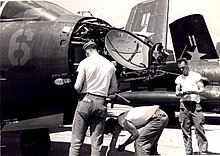

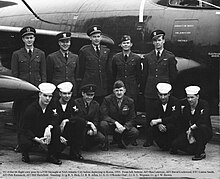

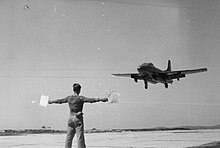
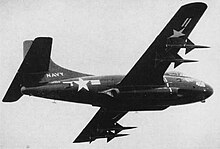
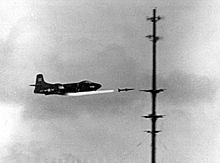
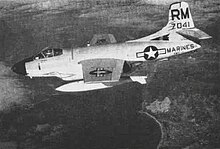
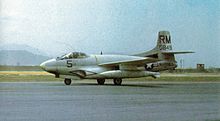
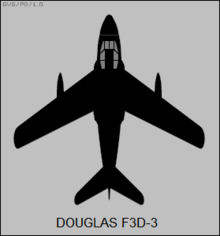

Skyknight (disambiguation)Federal ReporterFighter aircraftUnited StatesManufacturerDouglas Aircraft CompanyUnited States NavyUnited States Marine CorpsDouglas F6D Missileerlater redesignatedjet fighter aircraftnight fighterair intercept radarmaiden flightWestinghouse AN/APQ-35fire control systemKorean WarBoeing B-29 SuperfortressesNorth American F-86 SabreMiG-15sChineseAIM-7 Sparrowair-to-air missileelectronic warfareVietnam WarEA-6A IntruderEA-6B ProwlerU.S. Marineforeign object damageEd Heinemannside-by-side seatingjet propulsionfolding wingejection seatspressurizing the cockpitDouglas A-3 SkywarriorhydraulicGrummanWestinghouse J30Bureau of AeronauticsGrumman F9F PantherRussell Thawwind tunnelwing fencesMuroc Air Force BaseWestinghouse J34MiG-15vacuum tubesemiconductorWestinghouse J46autopilotair conditioningbulletproofswept wingsKunsan Air Basesearch lightsMaster SergeantVMF(N)-513Yakovlev Yak-15Warrant OfficerPyongyangPolikarpov Po-2biplaneB-29 SuperfortressesChief Petty OfficerNAS Atlantic CitySparrowPacific Missile Test CenterNaval Ordnance Test Station China Lakebeyond-visual-range missileaerial reconnaissancebusiness jetsLockheed JetStarF6D MissileerAAM-N-10 EagleGeneral Dynamics-Grumman F-111BGrumman F-14 TomcatMarine Composite Reconnaissance Squadron One (VMCJ-1)Da Nang Air BaseRepublic of VietnamElectronic countermeasuresurface-to-air missilesradar jammingGrumman A-6 IntruderDouglas RB-66 DestroyeravionicstestbedF-4 PhantomradomeWestinghouseA-4 SkyhawkRaytheonHolloman AFBWhite Sands Missile RangeWestinghouse J34-WE-24Westinghouse J34-WE-32Westinghouse J34-WE-38Westinghouse AN/APQ-36United States ArmyNational Museum of Naval AviationNAS PensacolaFloridaPima Air & Space MuseumDavis-Monthan AFBTucsonArizonaFlying Leatherneck Aviation MuseumMCAS MiramarCaliforniaCombat Air MuseumTopeka, KansasLakewood, CaliforniaNaval Air Station Los AlamitosNational Museum of the Marine CorpsQuantico, VirginiaQuonset Air MuseumQuonset State AirportNAS Quonset PointQuonset PointRhode IslandAir Force Flight Test Center MuseumEdwards AFBMarine Corps Air Station El ToroEmpire State Aerosciences MuseumSchenectadyMassachusetts